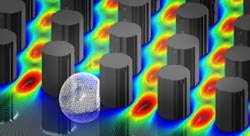Microfluidics: Sizing up cells

Deformable cells can squeeze between narrow gaps in a bump array of micropillars, leading to unpredictable paths in cell sorting devices <br>Copyright : A*STAR <br>
The ability to separate cells according to size and shape is useful in biological studies. One popular method of cell sorting involves the use of microfluidic devices consisting of a series of aligned micropillars. Such ‘bump arrays’ operate on the basis of allowing cells that are small enough to pass through narrow gaps, while cells that are too large undergo lateral displacement by bumping into the pillars. Blood samples, for example, can be separated into platelets, white cells and red cells using this technique. However, some particles that have deformable as opposed to rigid structures are prone to becoming ‘mis-sorted’, as they can bypass normal routes through the devices (see image).
Keng Hwee Chiam and co-workers at the A*STAR Institute of High Performance Computing have now completed a numerical study modeling ‘dispersive’ routes made in microfluidic devices by deformable particles1. “We wanted to arrive at an understanding of how cell deformability affects the device geometry and functioning, and hence help other researchers to optimize their devices in the future,” says Chiam.
The researchers created a two-dimensional computer model to examine the different possible routes taken by cells through the device pillars. In experimental observations, rigid cells either follow a zigzag pattern through the pillars, or they bump into the pillars and drop to the bottom of the array, depending on their size. The new computer model can accurately predict these paths.
In addition, the model can predict paths taken by large cells or particles that can change shape and squeeze through the pillars. These were found to follow a far more random path, sometimes moving in zigzag directions, sometimes bumping into the pillars, and sometimes getting stuck completely. These so-called ‘dispersive trajectories’ are dependent on the orientation, arrangement and size of the pillars present in the device. Chiam explains, “This shows us what design parameters to avoid, and we imagine that numerical simulations, such as the ones used by the aerospace industry in aircraft design, could benefit future biological technologies.”
The simulations could be improved by extending the computer model to a full three-dimensional representation of the cells and micropillars, but amassing the computational data required is currently cost-prohibitive. Chiam hopes, however, that future collaborations will lead to a three-dimensional version of the model and adds that the research team aims “to simulate the sorting of DNA strands instead of cells, to see if they can be sorted according to their length and sequence.”
The A*STAR-affiliated researchers contributing to this research are from the Institute of High Performance Computing
References
Quek, R., Le, D. V. & Chiam, K.-H. Separation of deformable particles in deterministic lateral displacement devices. Physical Review E 83, 056301 (2011).
Media Contact
All latest news from the category: Materials Sciences
Materials management deals with the research, development, manufacturing and processing of raw and industrial materials. Key aspects here are biological and medical issues, which play an increasingly important role in this field.
innovations-report offers in-depth articles related to the development and application of materials and the structure and properties of new materials.
Newest articles

Properties of new materials for microchips
… can now be measured well. Reseachers of Delft University of Technology demonstrated measuring performance properties of ultrathin silicon membranes. Making ever smaller and more powerful chips requires new ultrathin…

Floating solar’s potential
… to support sustainable development by addressing climate, water, and energy goals holistically. A new study published this week in Nature Energy raises the potential for floating solar photovoltaics (FPV)…

Skyrmions move at record speeds
… a step towards the computing of the future. An international research team led by scientists from the CNRS1 has discovered that the magnetic nanobubbles2 known as skyrmions can be…





















